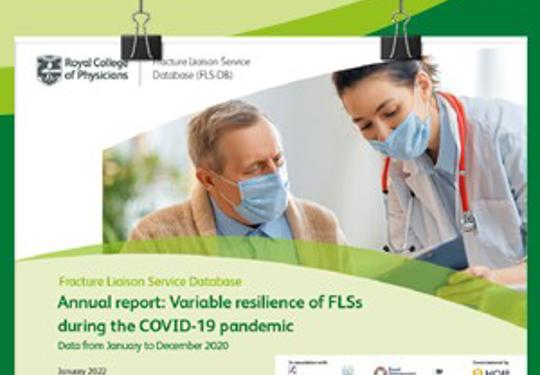This is the fifth annual report for the Fracture Liaison Service Database (FLS-DB), providing national benchmark performance for the care of people with fragility fractures in 2020.
Please note, the results in this report should be read within the context of the COVID-19 pandemic.
The Fracture Liaison Service Database (FLS-DB) began collecting patient data in 2016. To date, 75 FLSs have submitted patient data from over 300,000 patients across the NHS in England and Wales. In 2020 we welcomed services across Northern Ireland into the FLS-DB (data not included in the report).
This annual report presents the results of analysis on secondary fracture prevention care received by patients aged 50 and older in England and Wales in 2020, using the 11 FLS-DB key performance indicators (KPIs), which are complemented by the data presented in the benchmark tables and run charts publicly available on the FLS-DB website. Unsurprisingly in a year of additional pressures and redeployment due to COVID-19, there has been a decrease in achievement for most of the key performance indicators. However, four out of 11 KPIs saw an improvement despite the pressures that services were under.
Local commissioners and FLSs should use this report to improve the effectiveness in post-fracture care delivery from existing FLSs through service improvement and additional commissioning to reduce the number of preventable fragility fractures in this high-risk patient group.
If your organisation (hospital, primary care practice, network and/or other community service) treats fractures you need to participate in the FLS-DB.
If you, or someone you know has suffered a fragility fracture we have a number of resources for you.
- Given that approximately 10% fewer patient cases were submitted in 2020 when compared with 2019, FLSs should discuss the local pathways for fragility fracture patients with orthopaedic, geriatric and radiology colleagues at least every 4 months to ensure identification approaches remain effective and efficient.
- FLSs should review their methods for fracture risk assessment to ensure delays in DXA assessment do not affect rapid treatment initiation in high-risk patients and should consider how to address potential DXA backlogs / waiting lists caused by the COVID-19 pandemic based on regional or national guidance.
- The report states that at least 90,000 patients who should be receiving anti-osteoporosis therapy are not, therefore, service improvement alone will not be sufficient to close this care gap. Trust/health board management and commissioners should support FLSs to engage with their local integrated care system/health board to prioritise and resource FLSs based on local need.
Please read the full report for recommendations for a range of audiences including services, commissioners, and executive teams.





